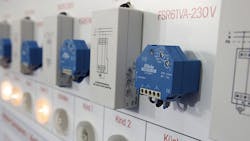The International Data Corporation (IDC) predicts that the Internet of Things (IoT) will consist of approximately 212 billion devices by the end of 2020. One of the main challenges is ensuring that the massive number of devices from different manufacturers can communicate seamlessly with each other. To confront this issue, the EnOcean Alliance and Open Interconnect Consortium (OIC) recently signed a liaison agreement to promote common frameworks for connecting IoT devices.
With more than 400 member companies, the EnOcean Alliance has developed a standard for building automation based on the principles of wireless energy harvesting. For its part, the OIC has started working on an open specification that serves as a common framework for IoT in a wide range of industries, from smart homes to healthcare devices and industrial sensors. The agreement will involve developing technologies using both standards.
The EnOcean standard, ISO/IEC 14543-3-10, is a wireless short-packet (WSP) protocol designed for energy harvesting in devices with extremely low power consumption. As energy harvesters, EnOcean devices can make use of energy created from slight changes in motion, pressure, light, temperature, or vibration. Because the energy source is present as ambient background, the devices are entirely self-powered, removing the need for wires and batteries. This makes the standard suitable for wireless autonomous devices, wireless sensor networks, smart lighting, and building control systems.
The EnOcean radio protocol uses an extremely short transmission period—less than 1 µs—to reduce the amount of energy consumed by the sensors. An EnOcean-based device has to produce a full radio command with just approximately 50 µWs (50 µJ) of energy, according to the group’s specification. The short transmission period also reduces the possibility of data collision and interference. The self-powered sensors build a foundation for the IoT, allowing data collection at places where wires or batteries reach their limits.
The EnOcean Alliance lays out the specifications for IoT devices based on the standard, which covers the physical, data link, and networking layers in the Open Systems Interconnection (OSI) model. These equipment profiles, as the organization calls them, ensure that devices from different OEMs can operate together in a complex building control system.
“The multitude of wireless and battery-less sensors represented by the EnOcean Alliance ecosystem are exactly what we have in mind when we say that software for the IoT has to be cloud-native from the start,” explains Mike Richmond, executive director of the OIC.
On its side, the OIC has taken the stance that “secure and reliable device discovery and connectivity is a foundational capability to enable the IoT,” according to the organization’s website. It has partnered with Cisco, GE Software, Intel, Mediatek, Samsung, and others to establish an open standard that stretches across multiple industries and technologies. To do this, the OIC plans to create a specification that combines existing wired and wireless standards and protocols.
In August, the OIC released an initial draft of its Candidate specification 1.0, which presents its proposed core architecture, security features, and remote access protocols. More recently, the OIC also began sponsoring IoTivity, an open-source software framework for connecting devices across operating systems and network protocols. The organization recently released a preview of the IoTivity source code for download.
About the Author
James Morra
Senior Editor
James Morra is the senior editor for Electronic Design, covering the semiconductor industry and new technology trends, with a focus on power electronics and power management. He also reports on the business behind electrical engineering, including the electronics supply chain. He joined Electronic Design in 2015 and is based in Chicago, Illinois.


